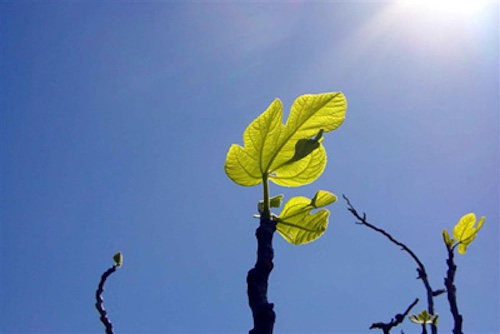The Greek Gods appropriated everything; for example the birth of the fig tree, described in two different myths. The first is about Dionysus who fell in love with the nymph Syka and changed her into a fig tree whilst he was drunk. A better known myth is about Syceus, one of the notorious Titans, sons of Gaia, the goddess of the earth. The titans were a bunch of giant hooligans, regularly bothering Zeus with their behaviour and he eventually declared war upon them. After one such a fight Syceus had to run from Zeus. He of course had no chance against such a mighty God, so his mother Gaia saved him by changing him into a fig tree.
The fig as a rescuer. The Greek hero Odysseus grasped just in time a branch of a fig tree when at risk of falling into a dangerous sea vortex created by the monster Charybdis. But most of all the fig tree did become a symbol for peace and prosperity. At the time of Solon, an Athenian politician (630 – 560 BC.), figs were such revered products that it was forbidden to export them to other countries.
Figs were so famous; you will find them named in most of the Holy Books. Once when hungry, Jesus walked up to a fig tree and finding it empty (it was not yet fig season), he cursed the tree. The next day the tree was from top to roots found dried out. Then Jesus explained to his pupils that if you truly believe in God, everything can happen. According to the bible, fig trees also grew in Paradise and when Adam and Eve sinned and had to leave the Garden of Eden, they shamefully covered their genitals with fig leaves.
It is known that the prophet Mohammed loved figs from Damascus, he also called them fruits from Paradise. In the Koran there is a chapter named after the fig. This Holy Book also says that God sees the fig and olive trees as symbols of creativity. And then there was Buddha, who became enlighted while meditating under a fig tree. Thereafter the fig trees became holy.
In the empire of the sage Solomon, last king of the Kingdom of Israel (ca. 1030 – 930 BC), the fig tree was also beloved and a symbol of peace and prosperity. As long as Salomon was king, the inhabitants of Juda and Israel could rest and meditate undisturbed under their fig and olive trees. Moses once said that The Promised Land was the ‘Land of the figs’. The current leader of Israel, premier Benjamin Nethanyahu, will never go down in history as a wise Solomon. During his reign peace under the fig trees has been savagely disturbed.
I am afraid that the Greek Gods actually have nothing to do with the first fig tree. According to scientists the cradle of the fig tree was in Yemen and in the Valley of Jordan where 11.000 years old dried figs have been dug up. From there figs were taken to the legendary empires of Mesopotamia and Egypt.
Cleopatra loved figs and had an Egyptian cobra hidden in a basket with figs smuggled into her rooms, in order to die by a snake bite. From Egypt figs came into Greece and later into the hands of the Romans and so the founders of the city of Rome, Romulus and Remus, could be brought up by a wolf under a fig tree.
Lesvos is full of these historic trees. Close to Eressos there are extensive fig orchards, but all over the island you may find enough fig trees along roads and paths where you can just pick the fruit yourself. Lots of saturated figs fall off the trees, where they also can be collected in order to make a syrup.
It is said that the Garden of Eden was in Mesopotamia (today’s Iraq). The fascinating novel There are Rivers in the Sky by the Turkish writer Elif Shafak, is partly situated in this area between the Euphrates and Tigris. It is known from legendary cities like Babylon and Nineva; when you read the book, the region’s fertile nature jumps from the pages. It is easy to imagine this could be about Lesvos, where in August there grow enough wild grapes to make tons of wine, where walnuts, like green magic balls, beg to get picked, where you stumble over fallen almonds and where sweet ripe figs fall into your lap. Just say, it’s a kind of Garden of Eden.
*The previous novel of Elif Shafak is about a fig tree on Cyprus: The Island of Missing Trees.











